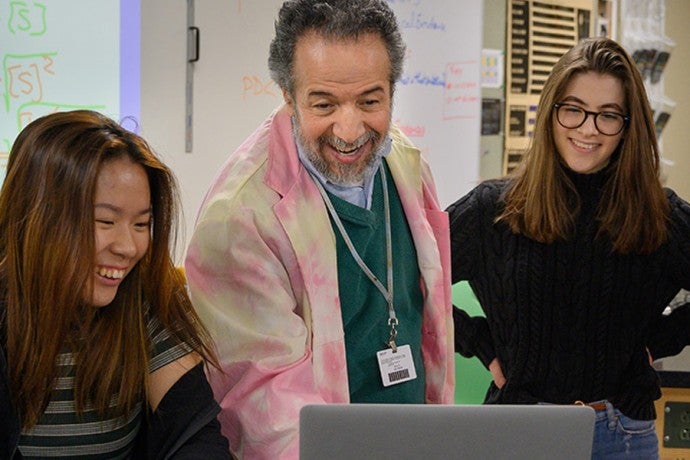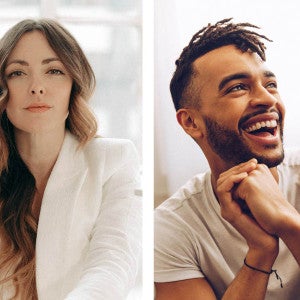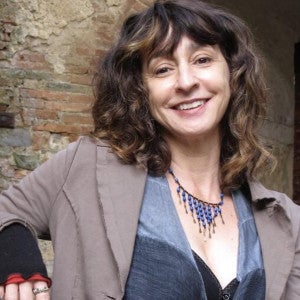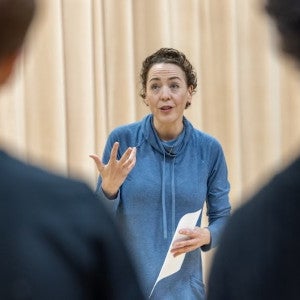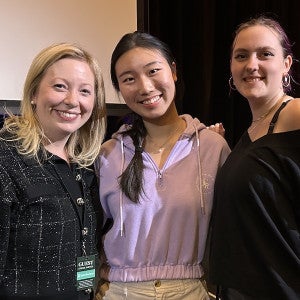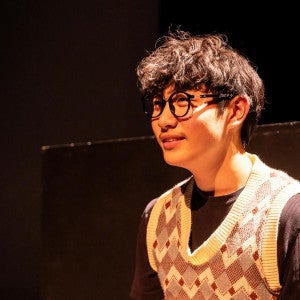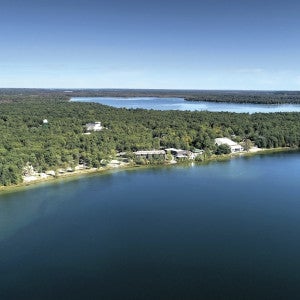Jean Gaede, an instructor of English at Interlochen Arts Academy, always helps Academy students find common ground with the authors they are studying. “When students read about the lives of the people who wrote these masterpieces, they can see that, in many cases, the struggles these people have are really quite similar to their own,” Gaede says. “The process of creativity is not an easy one.”
For decades, Interlochen Arts Academy’s academic instructors have adopted outside-the-box educational methods to bring math, science, history, and languages to life for their creative students. Instructors like Gaede tailor their teaching and curricula to complement and enrich students’ artistic pursuits.
This year, as Interlochen’s rigorous COVID-19 health-and-safety measures require both students and faculty to adopt new ways of learning, the Academy’s academic instructors continue this tradition of educational excellence, incorporating new mediums, formats, and technologies into their teaching—and redoubling their efforts to provide students with personalized guidance and support.
Academics for artists
Like Gaede, Taoufik Nadji, a physics and mathematics instructor, designs his courses in ways that encourage students to apply what they learn in his classroom to their own lives and interests. Instead of traditional timed tests, for example, Nadji often gives take-home tests that have two assessments related to reading, and one conceptual challenge, all of which encourage creativity.
“In the reading questions, students will take whatever they have read and reflect on it by making a small art piece such as a haiku, comic, or puzzle,” says Nadji. “For the conceptual piece, I ask them to use things from their own environment. In astronomy, for example, I might ask them to find the force of gravity between their dog at home and themselves on campus, instead of determining the force of gravity between two celestial objects. Many of my students have told me that this is a wonderful way of testing that they have never seen before.”
Instead of emphasizing classical physics—as most high school instructors do—Nadji focuses on modern physics. “Modern physics subjects, such as sound, optics, and acoustics, are naturally more interesting to artists,” says Nadji. “That doesn’t mean that I have given up on traditional physics, but it has become foundational so that I can get to these more interesting subjects.”
Abigail Conklin, one of Nadji’s students and a sophomore interdisciplinary arts major, particularly enjoys his emphasis on modern physics. “In my physics class, we learned about oscillating systems and nodes with respect to string instruments,” she says. “I love that I can get excellent training in my art area and continue expanding my knowledge in academics.”
For Gaede, who has taught at the Academy for over 20 years, the study of literature is a natural fit for emerging artists. “While students take literature as an academic course, the truth is that literature is art,” Gaede says. “If you can forge the connections between literature and whatever the student’s specific art area might be, it helps them to connect more fully with what they’re reading.”
Junior voice major Cassandra McCauley notes that the emphasis on artistic connections does not detract from the academic rigor of Arts Academy classes. “I attended an international baccalaureate program prior to attending Interlochen, and I find the academics at Interlochen just as challenging,” she says. “Interlochen has allowed me to immerse myself in my art while still being challenged academically. The smaller class sizes and more one-on-one time with teachers really help students to excel in their art and academic classes.”
Adjusting to COVID-19
Whether teaching on campus or online, the Academy’s academic instructors adapt their coursework to the changing circumstances of the pandemic.
For Nadji, labs pose the most significant challenge. “The sciences thrive through labs, so this fall I found different ways to keep them going,” he says. To avoid having students touch lab equipment, Nadji requires students to use their own items or objects. Additionally, students sit at opposite corners of tables, which allows them to work in groups while remaining socially distant.
To provide additional time for students to unwind this year, the academic schedule was designed with built-in “reflection days,” which are test- and deadline-free weekdays that allow students time to review concepts. As a result, academic faculty across subject areas have had to be more selective in their choice of study than in the past. “We understand that the kids are being asked to carry quite a burden,” says Gaede, of adapting to the unique challenges of this period.
Nadji also adjusts his material to prioritize his classroom time. One of his time-saving solutions has been to eliminate in-class tests. “Students are given three days to work on their tests outside of class, which gives them plenty of time to be creative,” he says. “I implemented this last spring, when we had to conduct classes virtually, so that I could use Zoom class sessions to run experiments or present ideas.”
Nadji’s outside-of-class tests offer another advantage: they are administered virtually to eliminate potential contact spread. “The only paper students use in my classes is their own notebook,” he says. Students take pictures of their assignments and upload them for grading to Canvas, the Academy’s learning management system.
A lasting impact
Through the efforts of teachers like Nadji and Gaede, Interlochen’s graduates continue to find success not only in the arts, but across all fields.
“Students have been very receptive to the arts-centric approach all along, and I think this is why many of our alumni go on to careers related to science,” Nadji says.
For instance, Will McClintock (AS 85, IAA 85-87), once an aspiring trumpeter, was inspired to pursue a career in marine science by studying ecology with longtime Arts Academy instructor Mike Chamberlin. Today, McClintock is a senior fellow and marine scientist at the National Center for Ecological Analysis and Synthesis.
“I was blown away by my academic experience,” McClintock says. “The combination of small class sizes and dedicated teachers drew me into a number of subjects that would shape my life following graduation. Mike Chamberlin set me on the course to become a marine scientist. My love of music and science were fostered at Interlochen in ways that continue to inspire me and my work today.”
Garth Greenwell (IAA 94-96), an author and literary critic, credits his Arts Academy academic instructors—particularly Gaede—with setting him on a path to success. “For the first time in my life, there were adults who modeled what it meant to live a passionate life of the mind,” he says. “It was a community of the most concentrated brilliance that I have ever been in in my life.”
